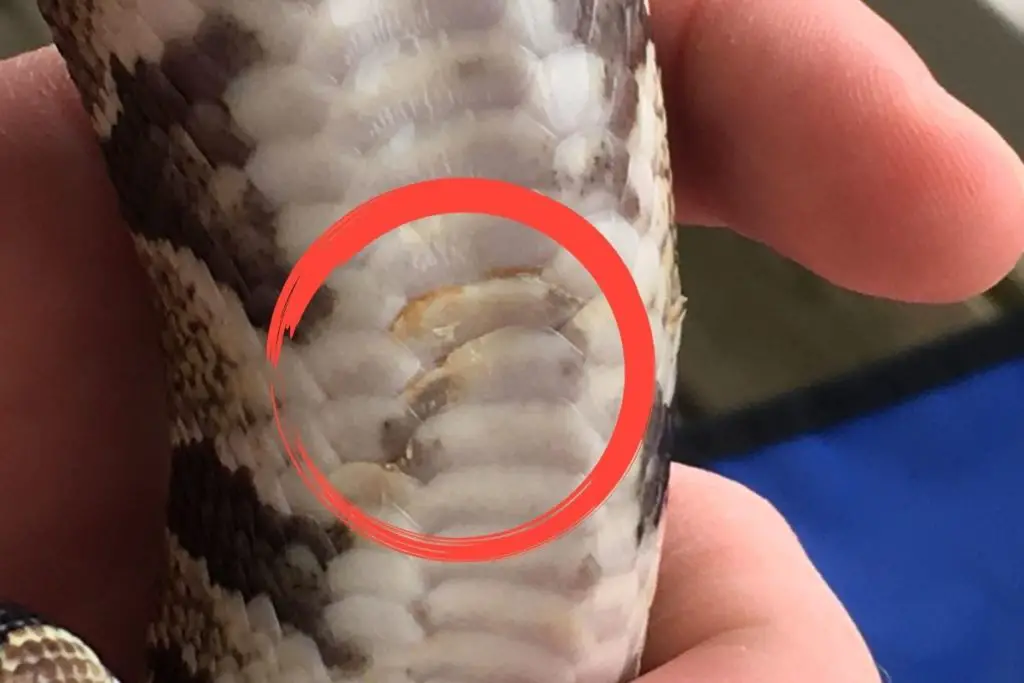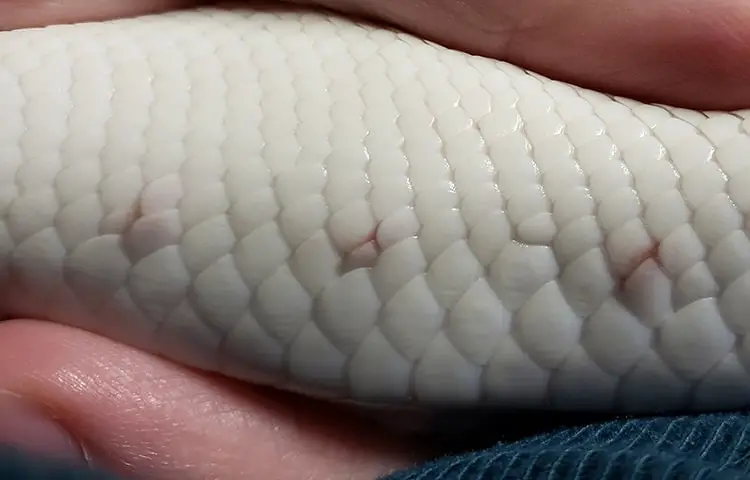Scale rot in snakes is a serious issue, and it’s one that can be fatal if not treated right away. Thankfully, there are a few of these serious health issues in pet snakes, at least relative to other pets, but you still need to know what to look for, what causes these issues, and what should you do should you actually notice them.
This is exactly what we’ll be doing here, plus we’re also going to discuss how to prevent this issue from happening in the first place, so stick around as I discuss the causes, signs, treatments (that work), and prevention tips for scale rot in pet snakes.
This article was reviewed and edited by a vet, but it shouldn’t serve as an alternative to your own vet. Please consult your vet for specific advice about your pet.
Contents
What is Scale Rot?

“scale rot” is a kind of umbrella term that refers to all bacterial, dermatitis, and skin diseases that occur among captive reptiles. Scale rot is prevalent in pet reptiles and is caused by an overly wet living environment and irregular and poor snake terrarium cleaning.
This can happen on your snake’s head, spine, or belly much more frequently than its neck or belly.
The disease attacks the keratin layer of the epidermis. The body tries to fight off the infection by forming a scab.
This scab is nourished by the body, and as it grows, it separates from healthy tissue beneath and can detach completely from the snake’s skin.
Scale rot is a disease that affects snakes, as well as other reptiles (even low-maintenance ones like the ball python). Germs can spread to a snake’s circulation and cause septicemia and death within days for tiny snakes if scale rot isn’t treated.
What causes scale rot?
Scale rot is basically caused by unsanitary or improper living conditions in their enclosure.
There are a few more reasons for scale rot that you should be aware of, in case one of the preceding factors has occurred.
Knowing the reason can help you cure and avoid future occurrences of the illness. It’s your responsibility as a proprietor to keep up with the health of your snake and their enclosure.
Let’s quickly go over each of the causes of scale rot in snakes:
Injuries or Damaged Scales
When your snake’s skin has been damaged, the chances of it rotting increase. Take any sharp objects out of their tank that might harm or cut their skin to avoid this from happening.
Examine any surface to see where your snake may slide and slither on and how best to prevent it from damaging its scales. Anything that appears dangerous should be removed or replaced.
You should also not feed your snake live rats or mice, as they can bite. You can learn about the other reasons why you should not feed your pet snake live mice here.
Too Much Humidity
In order for your pet to thrive and avoid scale rot, the correct level of humidity must be present in its cage. This is why it’s critical to figure out how much humidity your specific breed of snake needs because each species is unique.
If your snake’s enclosure is too humid, it can result in scale issues (scale rot). The humidity level in your snake’s cage plays an important part in its ability to shed properly. If your snake is unable to completely shed, the areas where its skin stays are more prone to scale rot.
There are a number of ways to keep your snake’s terrarium humidity at an acceptable level. Make sure you use proper bedding, utilize heat lamps correctly, and cover two-thirds of the top screen with plastic wrap to control humidity. Avoid putting the cage in direct sunlight or near drafts to avoid causing too much moisture.
If you don’t know the right humidity for your pet snake, make sure to check out this article on the reasons your pet snake is trying to escape to check out the table on the acceptable humidity levels for each species of pet snake I have in there.
The Temperature is incorrect
The temperature in your snake’s enclosure is determined by the species of snake you have. The majority of snakes require a cage that is between 75 and 85 degrees Fahrenheit. If you don’t meet their temperature needs, scale rot may develop.
A safe refuge for your snake is critical. Underneath the cave should be a precise heating source, and the temperature of this space should be kept consistent. Other parts of your snake’s habitat should be maintained about a degree warmer or colder than their resting place depending on the species. Again, the guide on the reasons snakes escape has a table with the right temperature for all pet snakes, so make sure to check it out.
Varying temperatures are needed in your snake’s habitat so they may thermoregulate (control their body temperature) as they would in the wild.
Because keeping your snake’s terrarium at the correct temperature is critical, you’ll want to invest in a few thermometers to check the floor, walls, and air inside.
I use this Digital Thermometer for all my snakes’ cages, and I have had a great experience with it so far. You can check it and learn more about it here (Amazon link) or by clicking on the image below:

Their Tank is Dirty
To avoid scale rot in snakes, you must also provide a sanitary enclosure. Every day, clean up your snake’s feces, uneaten food, and any shed scaled. Once a week, empty the terrarium and clean it thoroughly.
When you clean your snake’s enclosure thoroughly, remove everything. Clean the tank as well as anything that goes into it. Before putting your snake’s enclosure back together, wait for everything to dry.
You may use Q-tips, toothpicks, or razor blades to clean the terrarium’s corners more effectively. Only use cleaning cloths and towels that you have designated for snake upkeep to clean the terrarium.
You should also wear rubber gloves and goggles to protect yourself while cleaning the enclosure as snakes can carry parasites, germs, or bacteria without getting infected but still be able to infect you.
Some people prefer to put their own stones in the snake’s tank. If you wish to use your own outside stones in your snake’s tank, clean them and then boil them for 30 minutes before adding them into the environment. Allow them to completely dry and cool before adding them back to the tank.
Snake bedding made of newspaper or paper towels is ideal. Both are low-cost and easily replaced when they get soiled.
The signs of Scale rot in Snakes
It’s absolutely crucial that you are aware of the signs of scale rot in snakes and can quickly tell when you notice them that these are the signs of a problem.
As a snake owner, you should examine your snake’s body at least twice per week to make sure everything is normal and to be able to spot any of these signs before they become a serious problem. The sooner you spot the problem, the easier it is going to be to treat it and cure it completely before any permanent damage happens.
Here are the main signs of scale rot you should watch out for :
Change in color

It’s likely that your snake’s ventral scales have discolored due to scale rot if they are damaged or discolored. The scales closest to the cloaca are the most susceptible to scale rot.
The scales may be greenish-black, brown, yellow, or crimson in hue. However, it’s worth noting that blood vessels ruptured with scale rot may appear similar to shedding.
Look for additional symptoms of scale rot if you’re not sure whether the crimson discoloration around your snake’s scales is due to shedding or scale deterioration.
It’s also worth mentioning here that while usually it’s true that the ventral scales are the first scales to be affected, any of your snake’s scales can be affected by scale rot and it can happen to them in the beginning as well, so make sure to check all of your snake every time you do check for discoloration or signs of scale rot.
Raised Scales
The blood pooling beneath your snake’s scales might cause it to lift. You should be able to feel a difference in these scales if you run your hands down the length of your snake.
Check for additional indications of scale rot and check them more frequently if you discover raised scales.
Blisters

Blisters on your snake’s scales are another indicator of scale rot. Blisters are most likely to appear on the scales with the most surface area in your snake’s cage. These pus-filled blisters may be clear or golden yellow in hue.
Blisters seldom become infected at first. If scale rot isn’t treated, bacteria can infest blisters, causing them to get sick. In extremely rare circumstances, fungi may infect the blisters, resulting in a fungal infection.
Blisters that have become infected with germs will be red, swollen, and leak pus. Blisters may break open as a result of infection. Scales might fall off where infected blisters are visible on your snake’s body. After your snake sheds, you’ll be able to detect sores and ulcers in the area around affected blisters.
Blisters on your snake’s body might spread to its blood and cause septicemia if they aren’t treated promptly.
Loss of Appetite
If your snake’s appetite diminishes, check for scale rot. Appetite loss in a pet should always be considered serious. You don’t need to be concerned since we’ll discuss how to treat snakeskin when the scale rot is minor.
If you don’t know if your snake has lost its appetite or is just not hungry, check out this guide to how long should snakes go between meals where I discuss how much and how often should popular pet snakes eat.
How to Treat Scale Rot in Snakes
You can actually treat scale rot in your snake at home if you know what you are doing and catch it early.
However, it’s still advised that you contact your vet and at least give them a call to consult them and inform them of the situation, this is especially important for new snake owners.
Okay, now let’s look at how you can treat scale rot in your pet snake:
Quarantine Your Pet Snake First
I know the word “quarantine” gives all of us unpleasant feelings by now, but if you have more than one snake in your enclosure, there really is no way around it; you must quarantine your sick snake and put it in a separate enclosure.
Substrate should not be used in the affected snake’s habitat. Instead, line the bottom of the enclosure with paper towels.
Even if your snake lives in the tank alone, it’s still a good idea to remove all their substrate and replace it with paper towels to line the bottom until their scale rot is completely treated.
Treat the Rotten Scales

Cleaning the area affected by scale rot might help. Clean the afflicted scales twice a day with a chlorhexidine solution or a reliable reptile wound care product.
Here is my recommendation: The Reptile Wound and Skin Care solution from Vetericyn. Check it here (Amazon Link) or by clicking on the image below.

Bathing the afflicted scales in a diluted betadine solution is also effective. To make the betadine solution, combine one part betadine with three parts water. Soak your snake’s scales in it for five minutes twice a day for one to two weeks
After the afflicted area has been dried, apply an over-the-counter triple antibiotic ointment, such as Neosporin.
Pro Tip: You should not use any antibiotic ointment with pain-relieving agents on your pet snake.
If their scale rot is more severe, you should take your snake to the vet as they will be able to examine it and prescribe a stronger antibiotic ointment that works better for their condition.
Disinfect their tank
Finally, clean your snake’s cage thoroughly (and do it as needed). Temperatures and humidity should be checked at least once a day.
Take your snake to a reptile specialist if their scale rot does not improve or get worse in one week.
How to prevent scale rot in snakes?
“Prevention is better than treatment” is a saying that is always true, and it can save your snake a ton of suffering and save you a lot of time and money.
Here are some easy tips to prevent scale rot in snakes.
Keep their enclosure clean
Make a routine of cleaning their enclosure at least every other day. Remove any fecal matter, spilled liquids, and shed skin every day and as soon as you notice them.
Keeping the enclosure as clean as possible will go a long way in preventing bacteria from forming and infecting your snake.
You should also thoroughly clean all of the tank at least every other week. This includes removing and cleaning all the accessories, rocks, and anything else you may have for them in there.
Secure their Bowl in place
If your snake’s water bowl is wobbly, it has the ability to fall over. When spilled water remains wet, additional dampness and bacteria are produced.
Keep the humidity and temperature at the right ranges
We have already discussed this, but it’s worth saying at least one more time: maintaining the right temperature and humidity in your pet snake’s enclosure will go along way in keeping them healthy and preventing health issues like scale rot from happening in the first place.
Scale Rot in Snakes FAQs
Here are some of the common questions snake owners will have about scale rot.
Can Scale Rot kill your pet snake?
Scale rot can kill smaller snakes with a weak immune system according to studies, and it can also kill larger pet snakes if left untreated for weeks especially if the large snake is suffering from malnutrition or continues to live in unsanitary enclosures.
Scale rot can also kill your snake if it causes septicemia, which can kill the snake in a matter of a few days if not treated quickly.
Is Scale Rot contagious?
Scale Rot is contagious since it’s basically bacteria, and if you have more than one snake in the same enclosure, the infected snake can spread the disease to the other snakes if not quarantined.
How long does it take for snake scale rot to develop?
Scale rot can take a few weeks of living in unsanitary or improper conditions to develop in snakes.
Is Betadine Safe for Snakes?
Betadine is perfectly safe for snakes. The Betadine Solution is a must-have for Reptile First Aid and Wound Treatment.
Betadine is effective in treating and cleaning minor wounds, blisters, and burns on reptiles! If your reptile develops serious symptoms or doesn’t heal after four weeks, see a veterinarian immediately! You can also use it to clean your cages as well.
Conclusion
Scale Rot can be a serious issue for your pet snake, and it’s important to treat the infection quickly.
If you notice any of the symptoms in your snake or if they do not improve within seven days with treatment, please take them to a vet immediately!
A few easy steps that will help prevent scale rot are keeping their enclosure clean (especially by removing fecal matter), making sure the humidity is at an appropriate level, disinfecting all surfaces where water may come into contact with bacteria-infected scales, and scaling back on how often you feed them.
I hope this guide has helped answer some questions about scale rot for snakes owners out there who care about their pets’ health. If you have any other questions, please feel free to contact me and I’ll do my best get back to you as quickly as I could.
Helpful Resources
An introduction to the housing and treatment of snakes – Oliphant F. Jackson
If you like this article, please share it!

